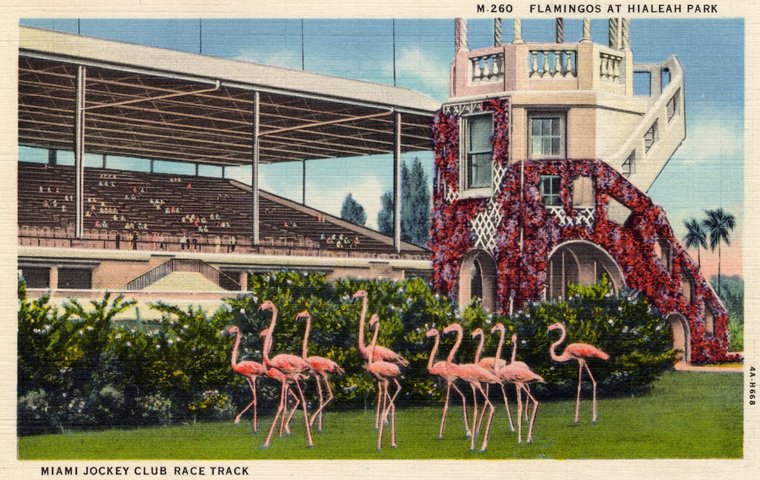
In the latest of her unmissable series, Rachel Pagones traces the storied history of a late, lamented Florida venue renowned for its elegance – and its famous flamingos.
If the divine hand ever reached down to strike a racetrack into being, that creation surely would have looked like Hialeah Park.
With its expansive park-like gardens, lush tropical foliage, fountains, flamingos, and a famously kind and forgiving track surface, Hialeah was a balm to the winter-battered souls of horses and humans alike coming from the more northern reaches of the racing circuit.
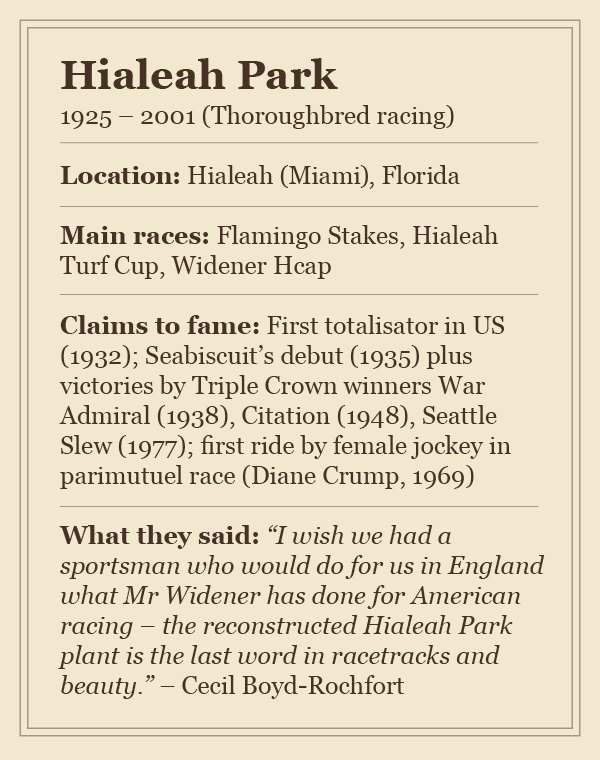 If those words sound fanciful, well, Hialeah was fanciful right from the start. Its whimsical, luxurious style befitted the wintertime sporting industry of Miami, whose purpose was to “create a round of enjoyment for every moment of the golden tropical day,” as Miami Herald columnist Isabel Stone wrote in 1925, the year of Hialeah’s opening Thoroughbred meet.
If those words sound fanciful, well, Hialeah was fanciful right from the start. Its whimsical, luxurious style befitted the wintertime sporting industry of Miami, whose purpose was to “create a round of enjoyment for every moment of the golden tropical day,” as Miami Herald columnist Isabel Stone wrote in 1925, the year of Hialeah’s opening Thoroughbred meet.
And the golden fantasy lasted through time. Joseph (Joe) Calascibetta, who arrived as an exercise rider from Suffolk Downs in Massachusetts in 1969, had never seen anything like the setting that greeted him at Hialeah.
Just breathtaking
He recalls: “The beautiful palm trees, and the apron of the track, and the flamingos, and the lake in the middle – it was just breathtaking.” Calascibetta stayed, ultimately training, with considerable success, for four decades at South Florida tracks.
Billy Tripp, who grew up in the city of Hialeah and began walking hots and then galloping horses at Hialeah as a teenager in the late 1960s, was enchanted by the track from an early age. “When I was a kid, going out in the morning was like going to Disneyland,” he says. “I loved being out there.”
As at Disney, the magic began as soon as you entered the grounds. Tripp remembers: “Driving into the main entrance, you come up to that giant ficus tree right before where you turn in, and then you turn into the clubhouse entrance area and it looks like a castle, with steps curling up on both sides going up to the upper deck.”
Former racing secretary Mike Antifantis, a fellow Hialeah homegrown, felt an almost ethereal beauty at times. Describing the broad path the horses would walk along from the stable area to the saddling paddock, he recalls: “Overhanging it was all the pine trees, and it looked like you’re going through a chapel of a church.” Hialeah was “the whole package … the whole place was just amazing to see.”
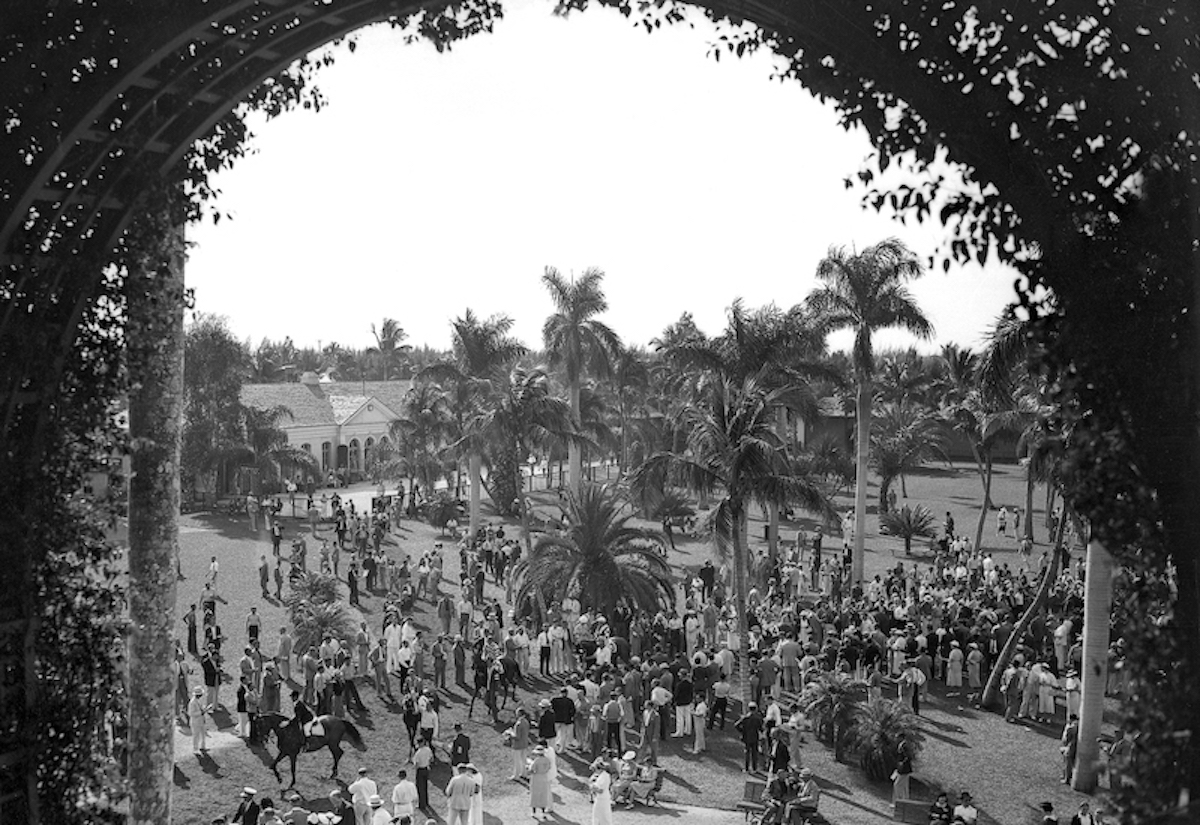 What other North American racetrack has been listed on the National Register of Historic Places, designated a sanctuary by the National Audubon Society, and been deemed eligible for designation as a National Historic Landmark by the US federal government? None, I submit.
What other North American racetrack has been listed on the National Register of Historic Places, designated a sanctuary by the National Audubon Society, and been deemed eligible for designation as a National Historic Landmark by the US federal government? None, I submit.
Vision and financing
Joseph M. Smoot, a wealthy northerner with political connections in New York, provided the vision and generated the financing for the new $1,100,000 Thoroughbred track, which opened on January 15, 1925 as the Miami Jockey Club.
A greyhound track had been running in Hialeah since 1922, and a jai alai fronton, rollercoaster and dance hall were added to the vicinity.
Remarkably, the racing complex was built in exactly one year. It included a grandstand and clubhouse together accommodating 20,000 visitors, 21 stables, and the one-mile racecourse laid with marl – a type of soil rich in calcium, which was hauled from the Everglades.
Smoot aimed to attract a certain set – “the high-rise money people from New York and Chicago,” in the words of former racing secretary Antifantis. In Hialeah’s early days, the green-and-red painted stables housed horses from such east coast powerhouses as Audley Farms, the Belmonts, and the Ward and Harry Payne Whitney stables, while racing itself attracted the wealthy and influential, or those who wanted to be.
Smoot’s vision and connections all seemed to come together during the inaugural 51-day meet. And it might have continued in that vein, but for another well-known south-Florida phenomenon – a hurricane.
The editorial page of the Miami Herald of Sept. 20, 1926 began with a frank proclamation: “Miami has suffered the worst disaster in its history.” Rather incredibly, it went on to call the damage “superficial” and to state that it could be “quickly and easily” rectified, while reassuring the “tens of thousands of winter visitors” that their fun-and-sun-filled playground would be intact when they returned.
Nevertheless, with the city under martial law, the paper reported that “South Beach amusement resorts practically were obliterated,” the casinos were “total wrecks,” there were dead and dying at makeshift hospitals, and hungry refugees were cooking fish thrown up onto the beach by the hurricane’s fury.
Given all this, the wrecked grandstand and flattened stables at the Miami Jockey Club racetrack were perhaps not the most important part of the “mass of wreckage” that was the town of Hialeah.
Indeed, Hialeah suffered the worst damage within the Miami area, and federal troops and breadlines replaced the usual throngs of tourists. Dogs from the Kennel Club were roaming freely, and the Miami Jockey Club grandstand roof was blown off.
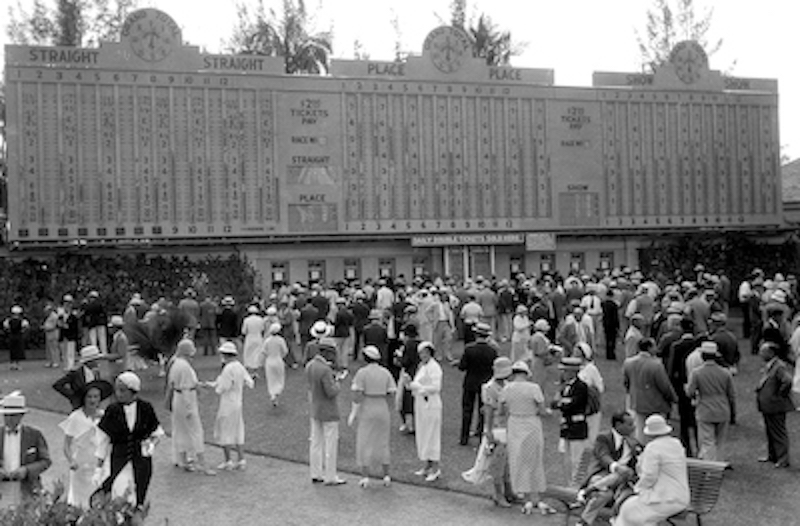 Intentions were for the winter sports to rebound quickly, but there may have been some complications. The New York Times in 1929 reported that Smoot had sold the Hialeah complex to two former business associates from Philadelphia, J. H. Carstairs and Barclay W. Warburton. A year later, Joseph Widener, at the time president of Belmont Park, bought Hialeah.
Intentions were for the winter sports to rebound quickly, but there may have been some complications. The New York Times in 1929 reported that Smoot had sold the Hialeah complex to two former business associates from Philadelphia, J. H. Carstairs and Barclay W. Warburton. A year later, Joseph Widener, at the time president of Belmont Park, bought Hialeah.
National importance
Widener saw Smoot’s vision and raised it. With architect Lester Geisler – best known for designing churches – he roamed Europe’s finest tracks and returned brimming with ideas from Ascot, Epsom, Deauville, and Longchamp, as well as a casino in Monte Carlo.
The rebuilt Hialeah Park opened in 1932, to an estimated crowd of 15,000. Present were the mayor of Chicago, a Russian princess, F. G. Riggs, the treasurer of the Maryland Jockey Club, and everyone who was anyone, apparently.
“Everywhere were men and women of national importance in various activities,” reported the Miami Herald. The new $350,000 Australian totalisator, prominently displaying the changing odds and declaring the winners in electric lights, was a big attraction.
The years that followed were fast and furious, as far as racing was concerned. There were luminous human visitors, including royal trainer Captain Cecil Boyd-Rochfort in that inaugural year, and prime minister Winston Churchill in 1946.
More to the point, Hialeah was an irresistible magnet for equines on their way to stardom. Seabiscuit made his racing debut – finishing fourth – at Hialeah in 1935. The subsequent Hall of Famer Black Helen beat the boys in the Florida Derby that same year. Citation scored three straight wins in the winter of 1948, ultimately meriting a statue imported from Italy that was erected in 1965. The mighty Forego won back-to-back Widener Handicaps from 1974-1975, while John Henry took the 1980 Hialeah Turf Cup.
Flamingos, flamingos everywhere
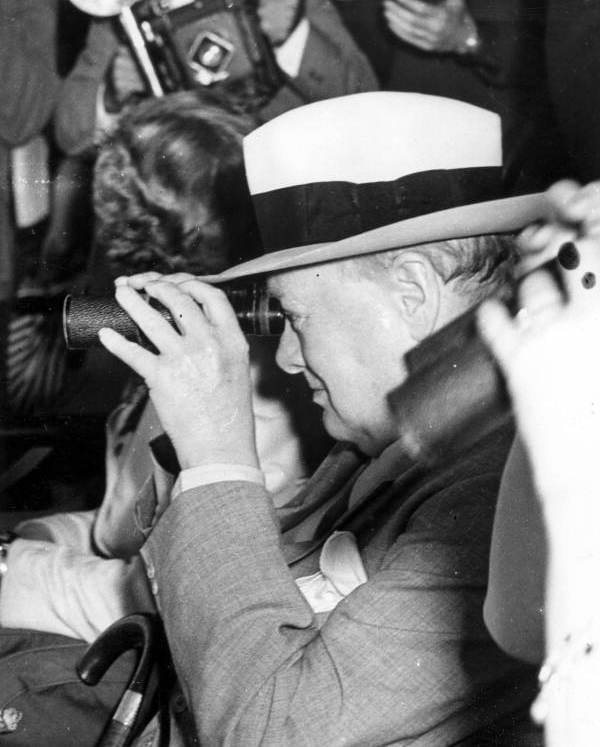 One race above all drew the top names, and established Hialeah as the place to be if your sights were on the Triple Crown trail.
One race above all drew the top names, and established Hialeah as the place to be if your sights were on the Triple Crown trail.
To preface: Widener’s greatest stroke of genius may have been the importation of flamingos from Cuba beginning in 1934. The famously pink birds eventually took to their infield home so well that they became a successful breeding colony which exists to this day. While the infield is no longer at the center of North American Thoroughbred racing, it remains a National Audubon Sanctuary.
There was no more iconic scene at Hialeah than a great flock of flamingos circling the racecourse every afternoon after the seventh race (rather unromantically, the birds were roused by an employee shaking a broom), as music was played.
And there was no more iconic race at Hialeah than the Flamingo Stakes. Run initially at the track in 1929 as the Florida Derby, and renamed in 1937, the nine-furlong race attracted the best three-year-olds in the country as they vied for a place on the Triple Crown trail. There in the warm, welcoming sunshine, crowds thrilled as the colts thundered past the finish line, and names that would become legend appeared on the Tote board.
Citation won in 1948, the second of four winners campaigned by Calumet Farm (the last was Alydar in 1978), and the last of four winners trained by Ben Jones – his first being subsequent Kentucky Derby victor Lawrin in 1938. Nashua took the honors in 1955 and Bold Ruler in 1957, both ridden by Eddie Arcaro, the most dominant jockey in the Flamingo in its early days. (Jacinto Vasquez and Jorge Velasquez both equaled Arcaro’s record of four Flamingo wins in the span of 1967-1988.)
Turn-to, whose stud career ultimately eclipsed his race record, won the 1954 Flamingo, while Needles in 1956 and Tim Tam in 1958 rounded out a decade of stellar results.
The ’60s featured Carry Back (1961), Never Bend (1963), Northern Dancer (1964), and Buckpasser (1966). Leroy Jolley sent out Foolish Pleasure and Honest Pleasure for consecutive wins in 1975-76, while Seattle Slew took the honors in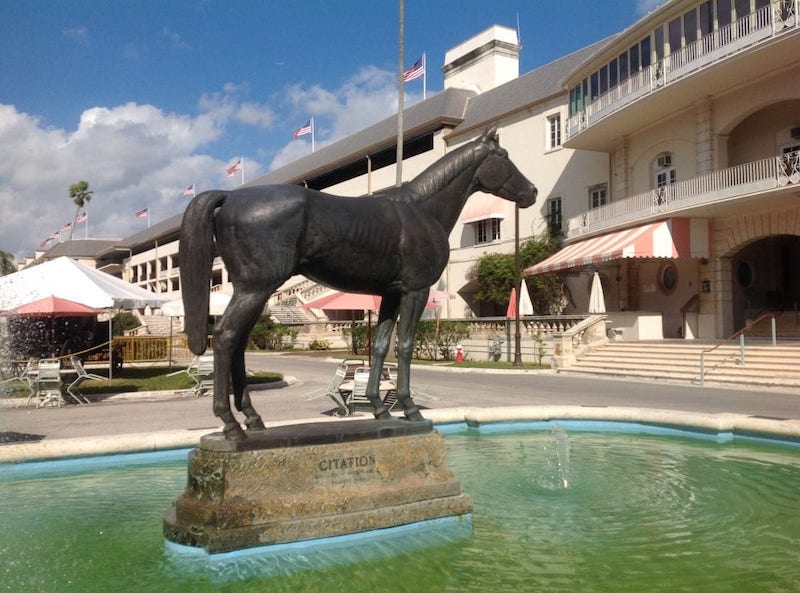 1977 on his way to Triple Crown glory and Spectacular Bid topped that with a record 12-length victory in 1979.
1977 on his way to Triple Crown glory and Spectacular Bid topped that with a record 12-length victory in 1979.
Chief’s Crown survived an ill-judged disqualification to land the title in 1985, although the quality of Flamingo fields generally tapered off from the 1980s on.
Making history
However, perhaps the least-heralded but historically important runner at Hialeah was a three-year-old named Bridle ‘n Bit. The colt was just a modest claimer, but thousands of eyes were glued to him as he entered the Hialeah parade ring on February 7, 1969, with 20-year-old Diane Crump aboard.
It was the first time a licensed female jockey would ride in a pari-mutuel race in the US, and onlookers knew it was an iconoclastic moment. Most, on the bulk of evidence, were not happy with that shattering of idols. But Crump, not one to be intimidated, didn’t care. “I was thinking it’s finally gonna happen! I can remember that very well,” she says now.
A security detail was deemed necessary to accompany her, through the crowds from the little room she was given to change in, all the way to the saddling paddock. “But you know what? It was okay, I was okay with it,” she says. “I didn’t care. I just wanted to ride races, that was my goal, that was what I was living for. And it was finally coming true.”
It wasn’t the first time a woman jockey had been named to ride in a race, but previous attempts were thwarted by boycotting male jockeys.
Following such an outcome at the Tropical Park meet at Calder a month earlier, which had led to the recalcitrant jockeys being fined, Hialeah made it clear the penalties would be stiff at their track for any attempted similar action.
Looking back now, Crump allows there was a historic element to her singleminded determination. “As you reflect, you’re grateful that you were a part of history,” she says. “That you did put your imprint there in a small way.”
As for Hialeah, she remembers it as “just a fantastic racetrack". Crump adds: “It’s sad that it shut down. It had just the most awesome feel to it because so many nice horses ran there.”
Old-school gentility
As momentous as Crump’s achievement was, the aura at Hialeah remained one of old-school gentility in the 1970s. The stables of Calumet Farm, Horatio Luro, Woody Stephens, Sherrill Ward, and the like filled the barn area. You could watch Forego ambling leisurely to the track, and Secretariat swallowing the distance between furlong poles. In the afternoons, horses were taken out to graze in the grassy areas between barns.
“Back then, each trainer had their colors,” recalls Jerry Murphy, who galloped horses for Luro in the 1970s. “So when you rode for Luro, you rode in a yellow and white jacket, you shined your boots every day. You weren’t yelling and hollering at someone on the racetrack. It was done properly.”
Both Calascibetta and Murphy recall Forego – a “gentle giant,” says Murphy – making a ponderous trip to the track each morning with his exercise rider, an older Black man known as Pinky.
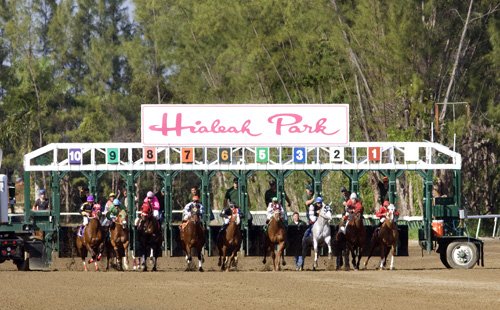 “The horse would take one step and stop, another step and stop,” says Calascibetta. “I used to say to him, ‘How’s old Gimpy going?’ And he’d say ‘Gimpy worked in 1:10 yesterday’ – oh he’s going pretty good then!”
“The horse would take one step and stop, another step and stop,” says Calascibetta. “I used to say to him, ‘How’s old Gimpy going?’ And he’d say ‘Gimpy worked in 1:10 yesterday’ – oh he’s going pretty good then!”
In fact, recalls Murphy, Forego’s trainer Sherrill Ward suffered from severe arthritis and moved slowly himself. “It seemed to work out great,” he says. “It took them probably over an hour for that old horse to walk back, but he’d wait for that trainer to get there.”
Soybean surface
It seems enviable now amid all the controversy over track surfaces, but Hialeah’s remained a source of praise rather than complaint. The secret? It may have been soybeans.
“They used to plant soybeans in the off-season in the track itself,” says Mike Antifantis, who was racing secretary in the mid-1980s. “And then prior to the meet they would pull them up. They just turn that over every year and add a little bit of clay or whatever they needed, but that was the basis of how they used to keep the track so good.”
The bigger challenge for Antifantis was determining weights in the big handicaps – such as the Widener, at the time a G1 race. The 1986 running turned out to be the race of his dreams. With a field featuring the first three finishers from the previous autumn’s Breeders’ Cup Classic, it was deemed one of the most competitive in Widener history.
Turkoman won in track record time, but not without a battle. “It was a great finish, three horses at the line,” says Antifantis. “It was the most exciting race I’ve ever handicapped for sure.”
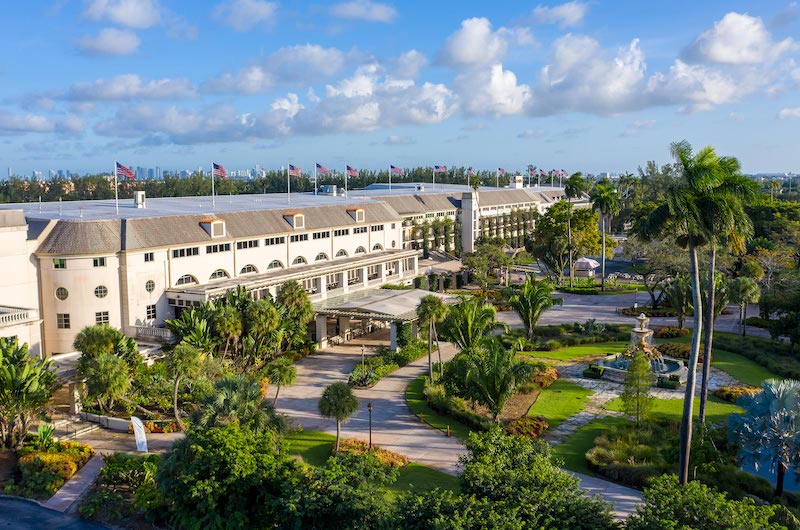 Yet while Hialeah still featured great racing in the 1980s, there were intimations of trouble. The track had been through a few ownership changes since Widener’s era, and after John J. Brunetti bought the complex in 1977, squabbles over the prime winter dates erupted.
Yet while Hialeah still featured great racing in the 1980s, there were intimations of trouble. The track had been through a few ownership changes since Widener’s era, and after John J. Brunetti bought the complex in 1977, squabbles over the prime winter dates erupted.
Historically, Calder had run its Tropical meet until early January, followed by 50 days at Hialeah and then 50 days at Gulfstream Park. To all involved, it was clear Hialeah had the best dates; attempts at renegotiation continually ended in failure, however, and twice Hialeah shut itself down due to those failures.
The end result was that thoroughbred racing was ceased at the track in 2001. Brunetti subsequently added Quarter Horse racing in 2009, and a casino in 2013, after a legal battle culminating at the Florida Supreme Court.
By 2017, the Quarter Horse feature had become racing in name only, what the trade journal Thoroughbred Daily News referred to as “match races between aged ponies”, which somehow fit the legal requirements for the casino to operate on the grounds. There is no longer any sort of live racing.
The flamingos don’t know the difference, though. They still fill the infield lake, and if Florida is a trip too far, you can watch their graceful flight in video on the Hialeah Park Casino website.
• Visit the Hialeah Park Casino website
Great racetracks we have lost: Hollywood Park and the dawning of the Breeders’ Cup era
Great racetracks we have lost: Rockingham Park – the ‘little Saratoga’ of New England
View the latest TRC Global Rankings for horses / jockeys / trainers / sires


